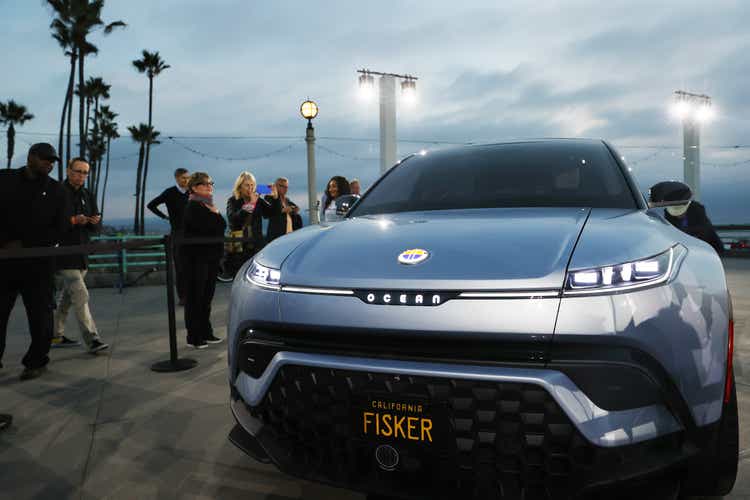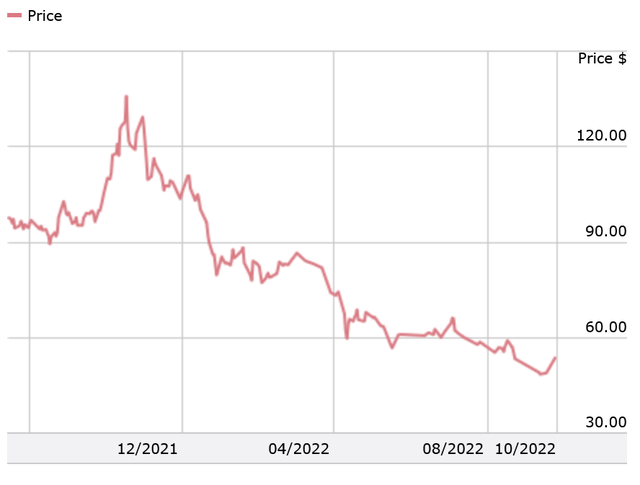Mario Tama
Fisker Inc. (NYSE:FSR) has rallied sharply off lows in mid-October, but shares have still fallen over 53% YTD as the startup inches closer to starting production and recording customer deliveries. Fisker is due to start production this month, with a limited number of deliveries this year before scaling higher in 2023.
Even as the electric vehicle (“EV”) startup is nearing and completing major milestones before generating revenues in 2023, the market is showing a significant lack of confidence in Fisker’s ability to succeed with its commercialization plans, tapping Magna Steyr (MGA) and Foxconn to mass-produce its vehicles. Given the lack of confidence, Fisker could be more susceptible to moves to the downside in the near term, although it has long-term potential.
Nearing Start Of Deliveries
Fisker is approaching the commencement of deliveries for its Ocean SUV, with the start of production slated for November 17. Fisker is achieving manufacturing milestones with the first production verification vehicles, a total of 95 prototypes, that have been produced for final validation and testing.
Deliveries for 2022 are likely to be limited in quantity due to the narrow turnaround time between the start of production and the end of the year, but 2023 opens up the possibility to rapidly scale production. Fisker has outlined that its agreement with Magna Steyr aims to produce 50,000 vehicles in 2023, tripling to 150,000 units in 2024.
Fisker also has an agreement with battery giant CATL for the supply of ~5 GWh of batteries annually for the Ocean, which amounts to ~50,000 units per year; over the course of the next three years, Fisker could see upwards of 150,000 units secured via this battery supply deal. However, the recent uptick in geopolitical tensions could affect this deal and/or future versions of the deal, adding the risk that Fisker may find trouble sourcing large quantities of batteries in a short time frame should it have to shift away from CATL.
Fisker has a hefty order book to work through, recording over 60,000 pre-orders for the Ocean and selling out all 5,000 units of the Ocean One. Fisker has been targeting 80,000 pre-orders by year-end.
The startup is looking to prioritize deliveries of its upper trims for the Ocean, the One and the Extreme, but has said that it will allocate extra production capacity to its lower trims. Fisker is not breaking down pre-order volumes by trim, but given its willingness to seek ways to increase annual production beyond 50,000 suggests that demand for all Ocean trims is healthy and robust.
Positives Ahead
Moving forward, Fisker is ready to scale deliveries into the tens of thousands next year and revenues into the billions, with the 50,000 vehicle target, with Magna Steyr paving the way for about $2.5 billion in revenue potential at that 50,000 unit volume.
Modelling off of 60% of that targeted volume (even as Fisker believes it has enough supply to hit its initial targets), to account for lingering supply chain issues, execution risk, pre-order cancellation risk, and macro headwinds still project revenues at $1.5 billion in 2023.
Fisker also has previously said it believes it can “potentially sell out capacity through most of 2023 with purchase orders of premium models.” For 2023, this equates to production volumes scaling while keeping ASPs in excess of $60,000, a very attractive picture for revenue growth.
For example: with an average ASP near $66,000 for 2023, assuming Fisker does allocate and sell some of its lower-priced trims next year, Fisker would be on track to generate ~$1.98 billion in revenues at 30,000 units; at 50,000, revenues could be in the low $3 billion range (although ASPs could dip).
In 2024, Fisker is set for more growth via the launch of its second model. Fisker and Foxconn plan to begin production of the Pear in Ohio, and “expect to build a minimum of 250,000 Fisker PEAR units a year at the plant after a ramp-up period.” Although initial volumes in the launch year are expected to be minimal, Fisker could be operating in excess of 150,000 vehicles per year by 2025/2026.
Signs Of Little Confidence
Even with Fisker nearing the cusp of delivery commencement and revenue generation with the potential for rapid growth in 2023, the market is showing little confidence in the automaker – Fisker’s convertible bond trades far below par, shares have 33% short interest, and the company trades at a 16% discount to its SPAC valuation and at a discount to peers.
Fisker’s $667.5 million convertible notes due 2026 are trading far below par value – the notes last traded on October 25 at $54.06, a 46% discount to par. While some of this stems from the share price decline, at $8.15 relative to the convertible price of $19.70. The convertibles trading this far below par with four years until due demonstrates the market’s doubts around Fisker’s probabilities of success – by 2026, Fisker should be operating north of 300,000 units annually, with multiple vehicle models on the market; assuming that at such scale, Fisker could be operating in a free-cash-flow positive state, with single-digit to double-digit net margins. If so, the company would easily be able to pay off this debt; however, the value of the notes currently places substantial doubt on Fisker’s ability to repay.
Aside from the bonds trading far below par, Fisker’s high short interest ratio also suggests confidence in its shares is falling. Fisker’s estimated short interest as of October 28 was 35.38%, with a 19.59% cost to borrow. Fisker has one of the highest short interest ratios in the EV industry, as the market is placing substantial bets against the EV startup.
Rival Lucid Group, Inc. (LCID), another heavily shorted EV startup with 22% short interest, is on track to generate just ~$850 million through 2022 after slashing production output this year by over 60%. Lucid is projected to end the year with an ASP near $130,000 in its first full year after production, as ASP has been trending negatively as lower-priced trims hit the market.
Taking a quick comparison, the upside potentially looks to predominantly favor Fisker in this scenario – revenues are projected to be more than double of Lucid’s, putting Fisker at a very attractive 1.4x EV/sales multiple (on the $1.5 billion revenue/30k unit projection) ahead of continued strong growth in deliveries and revenues in 2024; Lucid is valued at over 28x sales in its first year of its delivery ramp. Even accounting for the possibility to raise $750 million or so in cash, Fisker still trades at just 2x sales.
In addition, Fisker is also trading at a fair discount to its SPAC valuation, although the SPAC boom in 2021 saw dozens of companies generate multi-billion dollar valuations only to lose over 80% of value in less than twelve months. Unlike IPOs, SPACs allowed these firms to provide forward-looking financials to boost interest and valuations. Fisker has struggled to hold on to its SPAC valuation, sitting about 16% below its $2.9 billion SPAC valuation – trading at this discount as the company is now just weeks away from commencing deliveries and generating revenues also points to the market remaining dubious about Fisker’s (and/or the EV startup cohort) prospects.
This relative valuation mismatch, along with the bond price, short interest, and discount to SPAC valuation suggests that the market is either: a) concerned that Fisker will be unable to scale to these degrees or not confident that the company can get off the ground; or b) attaching lower multiples to the EV industry as a whole, a theme that has been seen already this year.
Outlook
Fisker is nearing a long-anticipated start of production for its Ocean SUV, with production expected to begin November 17 and with deliveries commencing shortly after. Although deliveries and revenues are expected to be minimal this year, Fisker is prepared to scale significantly with partner Magna Steyr in 2023, setting up the way for an attractive delivery ramp through the year with around $1 billion in revenue potential at 60% of its targeted production volume.
However, the market is expressing significant doubt about Fisker, with its convertible bonds trading far below par, in part due to the share price discount relative to the convertible price, its high short interest, and relatively low valuation alongside a discount to its SPAC valuation. As such, Fisker shares could be primed for underperformance in the short term and be prone to downside volatility even with growth being unlocked.



Be the first to comment